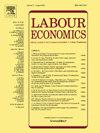Working from home after COVID-19: Evidence from job postings in 20 countries
IF 2.6
2区 经济学
Q2 ECONOMICS
引用次数: 0
Abstract
Remote work surged during the COVID-19 pandemic. To analyze its post-pandemic persistency, we construct an original dataset measuring remote and hybrid work (WFH) in 20 OECD countries and 55 occupations from January 2019 to December 2023, based on over 1 billion job postings from the global job site Indeed. The share of job postings advertising WFH more than quadrupled from about 2.5 % to around 11 % between January 2020 and January 2023 in the average country in our sample, continuing to grow even after pandemic-related restrictions were phased out. Exploiting changes in pandemic severity across countries and differences in the feasibility of remote work across occupations in a difference-in-differences design, we find that increases in pandemic severity substantially raised advertised WFH, but pandemic easing had no effect. We then use job search data to document persistently high interest in WFH from jobseekers and conclude that the post-pandemic persistency of WFH may partly be a response by employers to demand for flexibility from workers.
2019冠状病毒病后在家工作:来自20个国家招聘信息的证据
在2019冠状病毒病大流行期间,远程工作激增。为了分析其大流行后的持续性,我们构建了一个原始数据集,测量2019年1月至2023年12月期间20个经合组织国家和55个职业的远程和混合工作(WFH),该数据集基于全球求职网站Indeed的10多亿个招聘信息。在我们的样本中,在2020年1月至2023年1月期间,平均每个国家的招聘广告中,WFH的比例翻了两番多,从2.5%左右增至11%左右,即使在与大流行相关的限制措施逐步取消之后,这一比例仍在继续增长。在差异中差异设计中,利用各国大流行严重程度的变化和跨职业远程工作可行性的差异,我们发现大流行严重程度的增加大大提高了宣传的工作时间,但大流行缓解没有影响。然后,我们使用求职数据来记录求职者对工作时间的持续高兴趣,并得出结论,大流行后工作时间的持续存在可能部分是雇主对工人灵活性要求的回应。
本文章由计算机程序翻译,如有差异,请以英文原文为准。
求助全文
约1分钟内获得全文
求助全文
来源期刊

Labour Economics
ECONOMICS-
CiteScore
3.60
自引率
8.30%
发文量
142
期刊介绍:
Labour Economics is devoted to publishing research in the field of labour economics both on the microeconomic and on the macroeconomic level, in a balanced mix of theory, empirical testing and policy applications. It gives due recognition to analysis and explanation of institutional arrangements of national labour markets and the impact of these institutions on labour market outcomes.
 求助内容:
求助内容: 应助结果提醒方式:
应助结果提醒方式:


